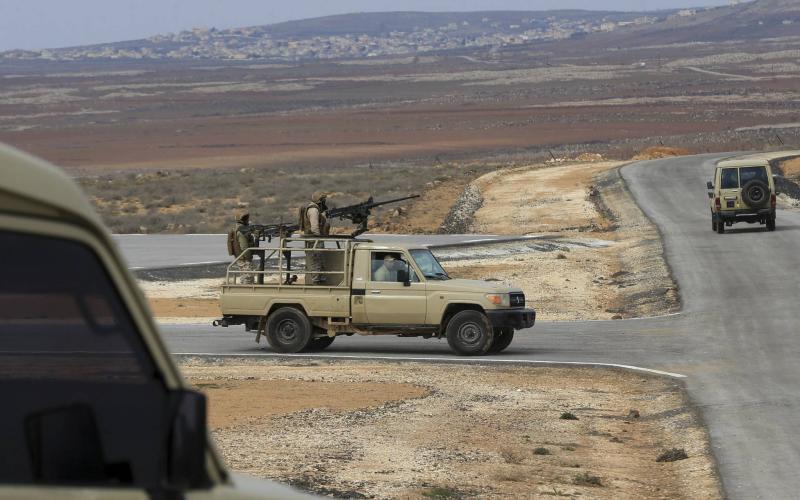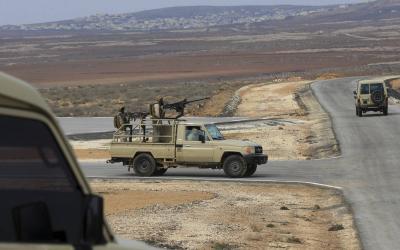The battle fought by the Jordanian army for several hours against armed groups attempting to cross its northern border with Syria marks a turning point in smuggling operations and highlights the nature of the parties controlling the other side of the border. The clashes, which lasted over 14 hours, ended with Jordan announcing the arrest of 9 smugglers and the seizure of 4 million Captagon pills, weapons, ammunition, and rockets, along with the destruction of a vehicle loaded with explosives. A "plot to target national security" was revealed, as stated in a report carried by official media from a military source. This was followed by a series of airstrikes targeting locations in the Syrian provinces of Daraa and Sweida adjacent to the border.
According to the Syrian Observatory for Human Rights and activists in southern Syria, the locations targeted by the strikes, which bore Jordanian fingerprints without being fully claimed by Amman, included the Al-Mataiya area near the border in Daraa and the Deibin, Shihab, and Salkhad regions associated with Sweida province. These targeted areas are close to the Jordanian border, and according to Reuters, airstrikes hit "hideouts for drug traffickers backed by Iran." The sources told the agency that "the bombing targeted the homes of major drug traffickers and farms identified by intelligence as safe havens for armed smugglers who also used drones to drop their shipments."
### Who Controls the Border?
Although the Syrian government lost control over the border with Jordan after the peaceful protests turned armed following the start of the Syrian revolution in 2011, it regained military and security initiative after 2018 when it entered Daraa under a "settlement" agreement facilitated by Moscow. The agreement allowed the regime to redeploy its forces, known locally as the "Hajaneh," along the border and in most points stretching from the Yarmouk Valley in the southwestern corner to the administrative border of Sweida province, which was fundamentally under its control with no change in influence.
The length of the Syrian-Jordanian border is approximately 370 kilometers, extending from the Yarmouk Valley in Daraa to the Iraqi-Syrian-Jordanian triangle. The Daraa and Sweida provinces are not only administratively linked to the border with Jordan but also include the Damascus countryside province, which connects with open desert areas and is considered under regime control, believed to be the main launching point for smuggling operations.
As of the writing of this report, the Syrian regime has not commented on the "battle" that the Jordanian army claimed to have fought on Monday, nor on the airstrikes targeting locations in Sweida and Daraa. The Syrian Observatory for Human Rights reported on Tuesday that "five Syrians, including a woman and two children, were killed in airstrikes carried out by the Jordanian army near the Jordanian-Syrian border on sites used for drug smuggling operations toward the kingdom." The observatory explained that "the Jordanian warplanes conducted a series of airstrikes targeting areas from which drug trafficking linked to Hezbollah and Syrian security apparatuses is carried out," pointing out that "one strike in the Salkhad area of Sweida province resulted in the death of drug trafficker Nasser Faisal Al-Saadi," who is connected to Hezbollah and the Syrian regime.
In its statement, the Jordanian army clarified that the confrontations took place "within the responsibilities of the Eastern Military Region," which stretches to the border from the Al-Hammad area in the Damascus countryside, as stated by Rayan Maarouf, director of the "Sweida 24" network. Maarouf added that the confrontations and the attempt by smugglers to cross are believed to have originated from the Al-Hara area in the desert, and that the announcement about targeting a vehicle carrying explosives suggests that the attempt was from the desert, as the area is large enough for maneuvering.
### "Supply from Depth"
Jordan has always blamed the smuggling operations on militias "supported by regional powers," implicitly referring to Iran. It asserts that the rise in such activities is linked to the weakness of authority in Syria, along with the cover provided by entities within the "Syrian army." Meanwhile, Jordanian officials and writers close to the authority point to the involvement of Iranian-affiliated militias and "Hezbollah," which spread along the border and enjoy security cover from the "Fourth Division" led by Maher al-Assad, brother of the Syrian regime leader.
While the Syrian regime is considered to have the largest control over the southern border, a part is held by the "Free Syrian Army" and U.S. forces known as the "Tanf Base" and the 55-kilometer zone.
### "Nothing is Fixed"
King Abdullah II of Jordan has visited the Jordanian-Syrian border multiple times, sending a series of messages and warnings regarding his army's determination to confront cross-border warfare. Following recent Arab normalization moves, his foreign minister Ayman Safadi met with officials in Damascus, discussing several issues, with "cross-border smuggling" at the forefront, culminating in a meeting of army and intelligence leaders.
However, these meetings did not lead to tangible developments on the ground. On the contrary, smuggling operations took an upward trend, reaching the extent of heavy weapon and explosives smuggling. Nawar Shaaban, a researcher at the "Omran for Strategic Studies Center," explains that "smugglers do not rely on anything fixed in their operations along the border," dismissing the idea that they focus on a particular area.
Shaaban states: "We are talking about a large issue and not local gangs but international ones, using every gap from the border, from Daraa up to the border triangle." He believes that the airstrikes targeted drug and weapon caches, functioning as a stopover in the journey "from production to crossing to the target." He adds: "It is difficult to produce drugs in the targeted areas due to their geography. They are suitable for hiding and storage, and what happened targeted a shipment without striking the entire operation."
Daraa province has a very short border strip with Jordan, and there are villages, towns, and "border guards and Hajaneh" on both sides, not open areas. Thus, "it is unlikely that most smuggling operations pass through this area," says opposition activist Omar Al-Hariri. Al-Hariri recalls that in 2011, Jordan significantly tightened its control over its border with Daraa in preparation for preventing large waves of refugees, and this strengthened after 2018, reflecting on the context of smuggling as a whole.
He adds: "Operations from Daraa to Jordan are almost nonexistent, unlike as we move east where open desert areas begin to appear, whether belonging to Sweida province or the Al-Hammad desert under regime control." The spokesperson for the Jordanian government, Muhannad Mbaydeen, stated that "Jordan has repeatedly indicated that this confrontation is ongoing and is being waged against forces that want to spread drugs, smuggle weapons, and enhance their capabilities over time."
Mbaydeen added, according to Jordanian media reports: "We wish the Syrian government would take clear measures to stop the chaos and halt these operations," but this has not been achieved; thus, "Jordan will take all measures to confront these risks."




